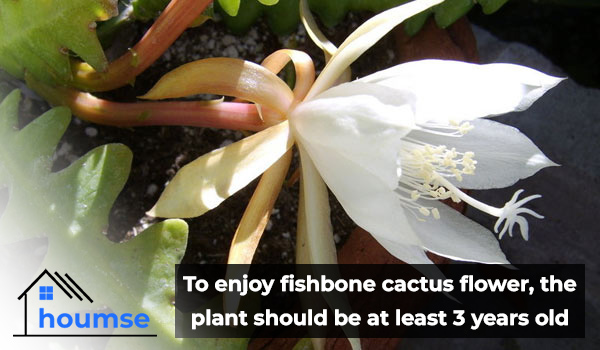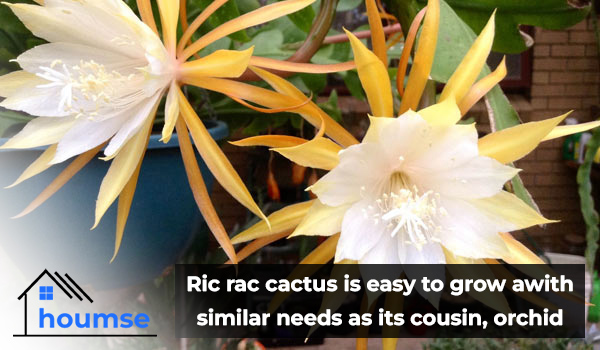Ric Rac Cactus Care Guide (Fishbone Cactus)

As a low-maintenance cactus that has no spikes, produces gorgeous flowers, grows quickly, and is not toxic to cats and dogs, the fishbone cactus is a dreamy houseplant. Also known as the ric rac cactus, orchid cactus, and zig zag plant, this specie is native to Mexico, and it is most known because of the unique shape that its stems have.
Thanks to its stems, this is a great plant for both hanging baskets and regular pots on shelves. In this post, we are going to know this succulent and its features better, and learn all about fishbone cactus care, how to get ric rac cactus to bloom, common problems, and propagation.
Fishbone Cactus Info
Best known for its long stems with jagged leaf nodes that arch gracefully, the ric rac cactus belongs to the night-blooming cactus family. In its natural habitat, you can find the fishbone cactus in groups, hanging from trees.
Judging by where it is from (tropical rainforests with a moist, humid environment) you can consider this plant a tropical cactus. The fishbone cactus is commonly found in garden centers, but (as mentioned) it is also excellent for growing in your home.
Let us get to know Epiphyllum anguliger’s characteristics better:
Fishbone Cactus Flower
Cactus flowers are probably the loveliest part of these plants; with the owner always looking up to them. And let us be honest, you cannot blame them.
To be blessed by fishbone cactus flowers, the plant should be at least 3 years old. The ric rac cactus’s bloom time is only a few days. During this period, its heavily scented soft pink flowers will open in the fall at night and last for one or two days. The blooms later turn into green, edible fishbone cactus fruit during the growing season.
Below, when covering ric rac cactus care, we will tell you how to get it to bloom.

Fishbone Cactus Aerial Roots
The ric rac cactus aerial roots are another fascinating feature of this houseplant. But why this plant is growing roots above the ground?
Aerial roots are very common among epiphytic plants like the zig zag plant. Many epiphytic plants develop these kinds of roots to absorb moisture and nutrients from the air. However, fishbone cactus aerial roots also serve as anchors.
Since Epiphytic plants grow on trees (and other plants) as their host in the wild and do not need soil. So, the ric rac cactus aerial roots for your houseplant may simply indicate that it is looking for something to cling to. However, it also may be a sign of poor humidity or a lack of nutrients.
When noticing fishbone cactus aerial roots, review ric rac cactus care instructions to make sure the plant’s needs are provided. You may need to water it or place the pot on a humidity tray.
How Fast Does Ric Rac Cactus Grow?
Apart from the fact that you need to wait for at least two years for the fishbone cactus flower, this plant is considered a fast-growing cactus. Each of its stems can grow up to a foot long; but as a houseplant, the stem length generally stays shorter.
For the fastest growth rate, you need to provide the right conditions for your plant which are discussed in the next part.

Ric Rac Cactus Care
Fishbone cactus is quite easy to grow and has similar requirements as its cousin, the orchid. This is how to grow fishbone cactus:
Ric Rac Cactus Light Needs
Start your fishbone cactus care checklist by providing the proper sunlight. Although it can handle a few hours of direct light or a little lower light, this plant grows best in bright and indirect sunlight. The right amount of light also encourages flowering.
Keep in mind that too much direct sunlight causes dark patches on the leaves. To solve this problem, remove the burnt leaves and place your plant in a shadier spot.
Ric Rac Cactus Watering
This is a tropical cactus with green stems and no spine. Therefore, unlike spiky desert cacti, it grows happily in humid environments. This translates into different water needs.
During the growing season, ric rac cactus watering is not very different than other plants in your home. Simply water it when the top two inches of the soil mix has dried out. Remember that the watering routine also depends on the soil. If it is well-draining and not dense, water more frequently.
Tropical cacti like the fishbone cactus are not used to cold water, as it can shock the roots. So, irrigate water using room temperature water. Also, if you use tap water for watering, leave it to stand for a couple of days before using it.
During the growing season, water once every 10 to 14 days. In cooler months, once a month would be enough. For zig zag cactus watering, it is crucial not to overwater and let your plant sit in water, which leads to different ric rac cactus problems.

Ric Rac Cactus Temperature & Humidity
To have the most vibrant version of this plant, the right humidity level is very important in ric rac cactus care. Again, as a tropical cactus, this plant grows on the branches of other plants in their natural habitat and enjoys a little bit more humidity.
Therefore, as a houseplant, it is a good idea to place it in sheltered spots like the kitchen or the bathroom, so your zig zag cactus can get a good amount of ambient humidity. While placing it in the best possible location (humidity-wise), keep an eye on the temperature as well.
Temperatures between 59 to 78 °F are ideal for this beautiful plant. In colder seasons, the fishbone cactus can handle temperatures as low as 50 °F; but it cannot tolerate frost. To provide the right ric rac cactus temperature, never place the plant near heat sources like radiators. All you need to do when there is a seasonal temperature shift is to put the heating on!
Ric Rac Cactus Soil and Fertilizer
A simple well-draining and rich mix are what your plant needs. As mentioned, heavy potting mixes take longer to dry out, reducing watering sessions. On the other hand, choosing a light and well-draining mix as the ric rac cactus soil lets the water flow easily and dry out faster.
Such mixes also mimic the conditions in its natural habitat for successful ric rac cactus care, providing the preferred aeration for the roots. You can use ready-made cactus mixes or make your own Epiphyllum anguliger soil by mixing a peat-free potting mix (or a specialized succulent mix) with cacti compost for the base and then adding some bark, perlite, and pumice.
In fishbone cactus care, it is also recommended to feed this plant for the best growth and chance for ric rac cactus to bloom. Fertilize it regularly with a high-quality 10:10:10 ratio fertilizer every two weeks, until the late summer or early fall.
When the fishbone cactus flowers bloom, stop feeding. Also, do not over-fertilize to avoid ric rac cactus problems such as brown leaf tips. Always follow the prescribed amount, as well as make sure that the soil is “damp” before adding fertilizer.
Repotting & Pruning
Another matter that makes the ric rac cactus care convenient, is that despite its fast growth rate, you do not need to re-pot it too often. Compared to its size, the Epiphyllum anguliger does not have a very big root structure. So, there is no need to re-pot it more than once every two years.
A few days before repotting, water it to reduce the risk of transplant shock. For the new pot, choose an unglazed one or a hanging basket that is only one size bigger (unglazed pots enhance evaporation and prevent the plant from sitting in water).
The ric rac cactus aerial roots and long stems tend to give it an untamed look. But if you feel that it needs a cut, you can always prune the stems (the super long ones). New stems will usually grow from where you cut, and make the plant look fuller than before. You can use the fishbone cactus cuttings for propagating too (discusses in the following parts).
Tip: Do not forget to wear gloves when repotting the plant or handling it in general. This species has tiny fine hairs that can stick into the skin and cause discomfort.

How to Get Ric Rac Cactus to Bloom
As mentioned, fishbone cactus flowers appear on plants that are at least 3 years old. If you have a young plant, the patience, and you are ready for this long game, this is how to get ric rac cactus to bloom in a nutshell:
During winter, keep your plant in a cooler place (52 to 57 °F), and the ric rac cactus soil is on the dry side. Check to see if any buds are forming; and when you spot them, increase watering, and place the pot in a warmer location (avoid extreme changes in temperature).
Keep the temperature of the soil at a constant level and make sure that it is not too hot. To do this, you can introduce a reflective material to your ric rac cactus care to avoid too much heat from the sun. Also, fertilizing regularly in spring and summer also increases the chance of fishbone cactus flowers.
Ric Rac Cactus Problems
If you pay enough attention to the fishbone cactus care, you will have a healthy plant resilient to pests and other common problems. If pests have attacked your plant, the reason is probably due to incorrect ric rac cactus care, very low levels of humidity, or under watering accompanied by a hot and dry condition.
Among ric rac cactus problems, mealybugs can be a serious issue, harming the stem crevices. If you see small fluffy white deposits, wipe them off using a cotton swab and rubbing alcohol. Spider mite or scale can also create problems if you have been under watering or have kept your orchid cactus in a location that is too bright for a while.
Tip: Applying ric rac cactus fertilizer during spring and summer will help your plant against pest attacks.
Let us discuss some of the common ric rac cactus problems in more detail:
- Leaves Turning Yellow: Yellow leaves indicate insufficient watering. To avoid this, we recommend setting a watering schedule to provide the proper care as well as prevent other ric rac cactus problems and diseases.
- Leaves Turning Brown: If your fishbone cactus leaves are browning, the reason is most probably receiving too much sunlight or too much water. Place the plant in a spot with bright but indirect light and be sure that the soil is dried out before watering.

Fishbone Cactus Propagation
Now you know everything you need to know about fishbone cactus care, but how can you propagate it?
All you need to propagate this beautiful jungle cactus is fresh cutting. Let it callous for a few days in a shady location. Then, plant it from the calloused end into a peat moss mixture (or any other low soil medium) and you are practically done. Keep in mind that the best time for fishbone cactus propagation is in spring to late summer.
Provide light moisture and medium-light for the stems. Soon you will have new plants for your succulent collection or give them away to other cactus enthusiasts that you know among family and friends. Happy gardening!
- In this post:
- Fishbone Cactus Info
- Ric Rac Cactus Care
- How to Get Ric Rac Cactus to Bloom
- Ric Rac Cactus Problems
- Fishbone Cactus Propagation



